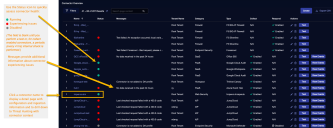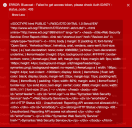Configuring SonicWall Capture Client Connectors
A SonicWall Capture Client connector allows you to disconnect host, initiate scan, restart machine, or shut down using Stellar Cyber (as long as those hosts are managed by SonicWall Capture Client), and ingest SonicWall Capture Client logs, discover assets, and see vulnerabilities.
There can be any number of SonicWall Capture Client connectors active.
Stellar Cyber connectors with the Collect function (collectors) may skip collecting some data when the ingestion volume is large, which potentially can lead to data loss. This can happen when the processing capacity of the collector is exceeded.
Connector Overview: SonicWall Capture Client
Capabilities
-
Collect: Yes
-
Respond: Yes
-
Native Alerts Mapped: No
-
Runs on: DP
-
Interval: Configurable
Collected Data
|
Content Type |
Index |
Locating Records |
|---|---|---|
|
ATP Host Log Threat Vulnerabilities |
Syslog Scans Assets Linux |
Domain
|
<Host URL> where <Host URL> is a variable from the configuration of this connector |
Response Actions
|
Action |
Required Fields |
|---|---|
|
Initiate Scan |
device.deviceId and device.InstallToken |
|
Disconnect Host |
device.deviceId and device.InstallToken |
|
Restart Machine |
device.deviceId and device.InstallToken |
|
Shut Down Host |
device.deviceId and device.InstallToken |
Third Party Native Alert Integration Details
N/A
Required Credentials
-
Host URL, Email, Password, Sonicwall Tenant ID
Let us know if you find the above overview useful.
Adding a SonicWall Capture Client Connector
To add a SonicWall Capture Client connector:
- Configure SonicWall log management
- Add the connector in Stellar Cyber
- Test the connector
- Verify ingestion
Configuring SonicWall Log Management
You must configure SonicWall log management before you add the connector in Stellar Cyber. You must also have the Tenant ID for an administrative user. MySonicWall credentials are not supported with the APIs.
To get the Tenant ID:
-
Log in to the SonicWall Capture Client console (https://captureclient.sonicwall.com) as an administrative user.
-
Navigate to Management | TENANT SETTINGS.
-
Copy the Tenant ID.
Adding the Connector in Stellar Cyber
To add a SonicWall Capture Client connector in Stellar Cyber:
-
Log in to Stellar Cyber.
-
Click System | Integration | Connectors. The Connector Overview appears.
-
Click Create. The General tab of the Add Connector screen appears. The information on this tab cannot be changed after you add the connector.
-
Choose Endpoint Security from the Category drop-down.
-
Choose SonicWall Capture Client from the Type drop-down.
-
Choose the Function: Collect to collect logs; Respond to enable endpoint actions.
-
Enter a Name.
This field does not accept multibyte characters.
-
Choose a Tenant Name. The Interflow records created by this connector include this tenant name.
-
Choose the device on which to run the connector.
-
(Optional) When the Function is Collect, you can create Log Filters. For information, see Managing Log Filters.

-
Click Next. The Configuration tab appears.
The asterisk (*) indicates a required field.
-
Enter the Host URL.
For release versions prior to v4.3.4, ensure the URL does not include a trailing "/" symbol.
-
Enter the Email.
-
Enter the Password.
The password should not include non-ASCII special characters.
-
Enter the Sonicwall Tenant ID you copied earlier, if you chose Collect.
-
Enter the Interval (min) if you chose Collect. This is how often the logs are collected.
-
Choose the Content Type you would like to collect, if you chose Collect. The logs for ATP, Host, Log, Threat, and Vulnerabilities are supported.
-
Click Next. The final confirmation tab appears.
-
Click Submit.
To pull data, a connector must be added to a Data Analyzer profile if it is running on the Data Processor.
The new connector is immediately active.
Testing the Connector
When you add (or edit) a connector, we recommend that you run a test to validate the connectivity parameters you entered. (The test validates only the authentication / connectivity; it does not validate data flow).
For connectors running on a sensor, Stellar Cyber recommends that you allow 30-60 seconds for new or modified configuration details to be propagated to the sensor before performing a test.
-
Click System | Integrations | Connectors. The Connector Overview appears.
-
Locate the connector that you added, or modified, or that you want to test.
-
Click Test at the right side of that row. The test runs immediately.
Note that you may run only one test at a time.
Stellar Cyber conducts a basic connectivity test for the connector and reports a success or failure result. A successful test indicates that you entered all of the connector information correctly.
To aid troubleshooting your connector, the dialog remains open until you explicitly close it by using the X button. If the test fails, you can select the button from the same row to review and correct issues.
The connector status is updated every five (5) minutes. A successful test clears the connector status, but if issues persist, the status reverts to failed after a minute.
Repeat the test as needed.
Verifying Ingestion
To verify ingestion:
- Click Investigate | Threat Hunting. The Interflow Search tab appears.
- Change the Indices to Syslog if you chose the Log or Threat content type. The table immediately updates to show ingested Interflow records.
- Change the Indices to Assets if you chose the Host content type. The table immediately updates to show ingested Interflow records. Also, hosts discovered through this connector show SonicWall Capture Client as a data source.
- Change the Indices to Linux Events if you chose the Vulnerabilities content type. The table immediately updates to show ingested Interflow records.
- Change the Indices to Scans if you chose the ATP content type. The table immediately updates to show ingested Interflow records.









